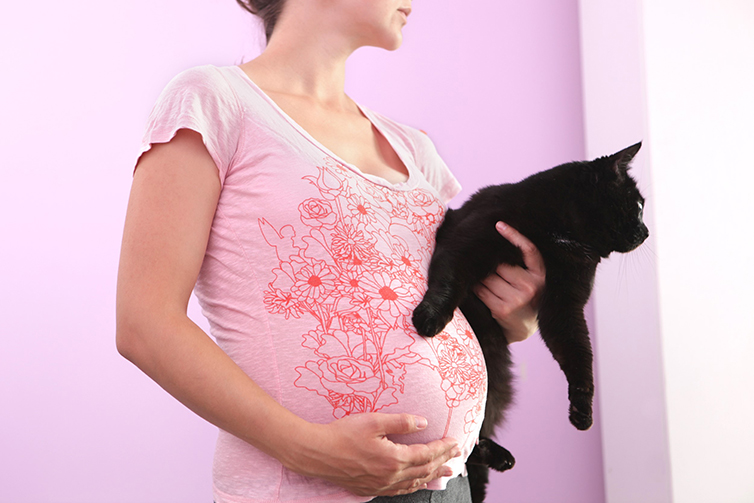Can humans catch diseases from cats?
Those of us who are fortunate enough to be a ‘cat parent’, know very well the benefits of being around a furry feline. Believe it or not, we and our human children visit the doctor less than those poor, misguided fellow humans who do not know about the pleasures of having a cat around the house. Cats are being taken into retirement homes and hospitals, as it has been found that stroking a cat helps to reduce stress and enables relaxation. Children with cats in their homes learn invaluable empathy and nurturing skills.

But rarely, it is possible to catch certain diseases from these furry friends, even though it is far more likely that you will pick up an illness from another human being. However, there are certain precautions that you can take in order to help prevent you and your family from catching any illness from your feline friends.
Let’s have a look at the diseases which may spread from cats to people. These are called zoonoses (plural). We are going to discuss each zoonosis in turn and explain their symptoms, diagnosis, treatment and prevention. Remember: forewarned is forearmed! You may then be able to prevent yourself or a member of your family from contracting one of these diseases or from getting seriously ill.
Let us first of all repeat though that catching a disease from cats, or indeed from any animal, is rare.
Zoonoses

Actually, you will be relieved to learn, there are very few cat diseases which can spread to humans. You don’t need to worry about distemper, cat flu, colds, feline AIDS or FIV (Feline Immunodeficiency virus).
The main zoonoses in South Africa are rabies, toxoplasmosis, salmonella, cat scratch disease, campylobacter, cryptosporidium, giardia, roundworm and ringworm.
- Rabies

Sometimes, a cat may be infected by another animal carrying the virus in their saliva. It is more common in dogs and can be spread when a rabid cat bites a person or when contaminated saliva comes into contact with exposed wounds or mucous membranes. This is the most common method of transmission. Rabies is fatal in unvaccinated humans and animals once symptoms appear, so it is vitally important that treatment from a vet if a pet is bitten, and a doctor if a person is bitten, is sought immediately.
The wild animals which are infected are usually mongoose, black-backed jackals or bats. Any bite from a wild animal or a domestic one which is showing abnormal symptoms, needs immediate medical care. Dogs are the most common domestic pets affected by Rabies.
- Signs and Symptoms
Signs in humans may begin with flu-like symptoms, including fever, nausea, sore throat, headache and vomiting. Agitation, depression and an inability to sleep, followed by excessive salivation, excitement and aggression will usually follow. Painful spasms of the throat may happen as rabies affects the area of the brain involved in swallowing and breathing. Swallowing water may become very difficult.
- Diagnosis
When a human has been bitten by a wild/feral animal, brain tissue of the animal responsible for the bite must be examined in order to confirm a rabies diagnosis. Viral testing of the human who has been bitten, is not effective for a rabies diagnosis. A PCR test can confirm or rule out rabies, only once symptoms have begun.
In the case of a domesticated cat, without symptoms, who has bitten a person, the cat may be isolated by the vet, who will watch for symptoms for 10 days. Unfortunately if the cat is unvaccinated against rabies it will need to be euthenised.
- Preventing and Treating Rabies
People who work with animals, such as vets, game rangers and animal shelter workers, should be vaccinated against rabies, then have their titres measured every 1-2 years and determine if they need to be booster vaccinated. The most effective way to prevent rabies is to ensure that dogs and cats are vaccinated against Rabies.
When a person has been bitten by an animal which may be rabid, immediate steps must be taken. The wound should be cleaned with disinfectant and hot water as soon as possible. A rabies vaccine must be administered immediately. If treatment is delayed, humans can still die from rabies. If a cat, or any animal, who bites someone, is not known to the person or is wild or was acting strangely, then that animal should be considered to be potentially rabid.
2. Toxoplasmosis

This is an infection caused by a minute but very nasty parasite. It can be carried by most animals but only cats can shed the eggs which cause this disease. It is passed on by the cats eating rodents, insects or from being in contact with other infected cats.
People who come into contact with cat faeces when cleaning litter trays, gardening or when children play in areas where cats can defaecate (in other words, almost anywhere outside), and do not wash their hands thoroughly afterwards, may pick up this disgusting parasite. It is particularly dangerous for pregnant woman, as it can cause miscarriages and birth defects.
- Symptoms
In babies, if infected after birth, symptoms may be mild but may appear years later. In babies and adults, symptoms may include a general feeling of being unwell, fever and swollen lymph nodes. The disease is particularly serious for those with a compromised immune system.
- Diagnosis
A blood test is used to diagnose this disease. For those with compromised immune systems, a CT or MRI brain scan may be required.
- Treatment
For most people who acquire toxoplasmosis after birth and who have well-functioning immune systems, no treatment may be necessary. For those with compromised immune systems or pregnant women, medications are available.
- Prevention
Prevention is basically taking sensible measures to avoid picking up this disease, such as avoiding cat faeces/ litter (for pregnant women) and using rubber/plastic gloves for others. Hands should be thoroughly washed afterwards.
3. Campylobacter
If humans do not wash their hands thoroughly after being in contact with cat faeces, they may pick up this other nasty little beast. These are bacteria which may also be found in meat, poultry or untreated water.
- Symptoms
Diarrhoea (which may contain blood), vomiting, fever, dehydration and stomach pain are symptoms of this infection.
- Treatment
In severe cases, antibiotics may be prescribed, but usually no special treatment is required, unless symptoms are severe.
- Prevention
The usual precautions apply: Avoid contact with cats’ (and other animals’) faeces; wear gloves when cleaning litter trays and keep children’s sandpits covered when not in use.
4. Bartonellosis
This can be caused by a cat scratch and refers to the infection which may result. Cats themselves show no symptoms of this disease, which infects the blood vessel walls in humans.
- Symptoms
A crusty, red blister develops around the scratch, accompanied by fever, swollen lymph nodes, loss of appetite and headaches.
- Treatment
A blood test will confirm this infection and most people will recover without treatment but this can take from 2-5 months. Antibiotics and painkillers may be prescribed.
- Prevention
Avoid cats’ claws! Children need to be taught to be gentle and careful with cats, particularly kittens. Carefully wash and disinfect any scratches immediately.
5. Protozoa Parasites
These disgusting little beasties are called giardia and cryptosporidium parasites, which cause infections in the intestines. Infected cats may show no symptoms but contact with them may cause infection in humans.
- Symptoms
Severe stomach pains and watery diarrhoea are the usual symptoms.
- Treatment
Usually, the symptoms subside after a couple of days but for those with compromised immune systems, this infection could be very serious and medical help should be sought.
- Prevention
Direct contact with cats is the usual way this infection is passed on to humans. It is important to teach children to wash their hands after playing with kitty.
6. Salmonella
Salmonella bacteria cause food poisoning, leading to vomiting and diarrhoea. These nasties are found in the faeces and gut of animals and humans, and in food, especially in raw meat. Consequently, contact with pets or their faeces can cause infection. Thorough hand-washing after touching pets or cleaning litter trays is essential.
- Symptoms
Stomach cramps, fever, headaches and diarrhoea may be symptoms of infection.
- Treatment
A doctor should be consulted if the diarrhoea becomes severe, especially in the very young and very old. However, most cases resolve themselves.
- Prevention
Again, great care should be taken when handling litter trays and raw meat and poultry. Hands should be washed thoroughly with soap and hot water. Ensure that children’s sandpits are covered.
7. Ringworm
This is not a worm but a fungus, which causes circular lesions on the skin. It occurs in the dead layers of skin, hair and nails. It is easy to pick up through simply touching an infected animal. Ringworm is usually named according to its place on the body, e.g. athletes’ foot, which is a form of this infection. Warm, moist areas of the body, such as the groin or armpits, are particularly susceptible to infection.
- Symptoms
An itchy and painful rash is usually the first sign of ringworm infection, which may become scaly with blisters. It can develop in many areas of the body.
- Treatment
Fungal creams may be prescribed and the instructions for application should be carefully followed. Treatment should not be stopped too soon. Keep the infected area clean and dry.
- Prevention
Treat your pets and consult your vet if they show any signs of this infection, as it is very contagious.
8. Cat Roundworm

Cat roundworms can infect humans, and they are commonly found in countries or in situations where there is limited access to clean drinking water and where sanitation is poor. They can also be found in clean, sanitary conditions. These little uglies are cylindrical and may be short or long. The worms’ eggs are found in the faeces of the animal and can be transmitted easily if infected hands touch the mouth. The eggs hatch in the gut of the human, creating larvae which can pass through the gut wall and enter the bloodstream. (Yeuch!)
- Symptoms
Symptoms vary and may include coughing, fever, rashes, liver enlargement and pneumonia. Severity of symptoms depends on intensity of exposure to the eggs, the person’s age, and sensitivity to the larvae.
- Diagnosis
Doctors will usually recognize the symptoms or do a blood test. High white blood cells may indicate infection or faecal testing may reveal signs of infection.
- Treatment
The parasite may disappear without treatment in 6-18 months. (Who could live with this for that long?) Doctors can prescribe medication to treat this infection.
- Prevention
Deworm your animals regularly. Your vet will be able to prescribe suitable medication or you can buy it from a pet store or supermarket. Ensure that you get the right size for your pet’s weight.
And finally …

We’re pretty sure that you’ve all ‘got the message’ by now! Avoid cat faeces and litter if possible. Wash your hands thoroughly if you have been in contact with these, with soap, hot water and preferably an antiseptic. Wear plastic gloves if possible. Cover children’s sandpits when they are not in use. Teach your children the basic rules of hygiene when they are in contact with animals. Consult your doctor if anyone is bitten or injured by an animal.
And … love and enjoy your kitties!
ZA-NON-221100012

Subscribe to our Newsletter
Get to know your furry friend better! Sign up for all things dog- or cat-related.
The Hairy Facts about the dreaded hairball
12 April 2021
Help! My dog’s barking mad! Volume 2
12 April 2021
Your Itchy, Scratchy Cat – All About Cat Skin Problems
12 April 2021
The Dog’s Diet: A Bone of contention?
01 April 2021
Mango Fly Worms: How to Spot and Eliminate them
Posted on November 28,2019
Managing Mange And Mites In Your Dog
Posted on June 11,2018
Why Do Cats Purr and How? Learn What Your Cat Is Saying
Posted on October 14,2020
How to Get Rid of Ear Mites in Dogs
Posted on November 06,2019









